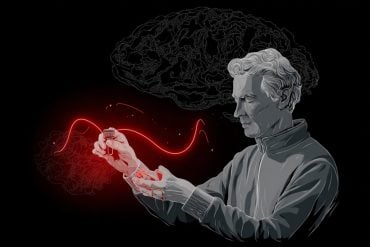Summary: A new study upends hundreds of years of belief that physiological responses to emotion are uniform. Researchers report there is not a single physiological fingerprint for each emotion, but a population of potential responses.
Source: Northeastern University.
How do you feel when you’re angry? Tense? Jittery? Exhausted? Is it the same every time? Is it identical to how your best friend, co-worker, or barista feel when they experience anger? In all likelihood the answer is no, that how you experience anger varies between situations, and that how you experience it varies from others.
According to new research from Northeastern, how your body physically changes during anger and other emotions can also widely vary—findings that upend hundreds of years of conventional wisdom.
Psychologists have long operated under the notion that categories of emotion—anger, sadness, fear, disgust, happiness, surprise—each have its own physiological fingerprint. For example, your blood pressure should go up when you’re angry or your heart rate should rise when you’re scared. That assumption, however, is not true. That’s according to new research led by Lisa Feldman Barrett, University Distinguished Professor of Psychology at Northeastern, Karen S. Quigley, research associate professor of psychology, and Erika Siegel, postdoctoral fellow at the University of California, San Francisco, and a former Northeastern doctoral student who started the work as part of her dissertation.
Barrett, Quigley, and their colleagues performed a meta-analysis of more than 200 studies that measured the emotional states and corresponding bodily changes of more than 8,400 people. The results, published recently in the journal Psychological Bulletin, showed that variation is the norm when it comes to physical changes during emotion. Former doctoral students Paul Condon, Yale Chang, and Molly Sands, as well as Jennifer Dy, associate professor of electrical and computer engineering, were co-authors of the study.
“We conclusively show across hundreds of studies that this common-sense belief—that each emotion has its own bodily fingerprint—is just false,” Barrett said.
For example, Barrett said bodily responses such as heart rate, respiration, and blood pressure fluctuate significantly across all emotion categories. The new study suggests there is not, in fact, a single physiological fingerprint for each emotion, but rather a population of potential responses.
In past research, Barrett has also shown there is little scientific evidence that emotions have specific facial expressions. “It turns out that people scowl in anger about 20 percent of the time. They make many, many different facial movements when they’re angry, and they also scowl at times when they’re not angry,” she said. “Variation, again, is the norm.”
What findings could mean for tech companies
Debunking this long-held myth could have major implications for technology companies that build emotion-reading gadgets and apps, Quigley explained.
“These companies usually assume that a pattern of peripheral physiological measures can tell you how a person feels, such as trying to detect ‘happiness’ using only physiological responses,” Quigley said. “This work shows that it is just not that simple.”

The new findings, Barrett explained, are relevant to companies focused on developing artificial intelligence platforms to read human emotion. “Instead of building one model that reads anger for everybody in the whole world, you may need to build a model that reads the variable changes in anger for a single person over time, depending on the context,” Barrett said.
Neil Harrison, Wellcome Clinician Scientist and Reader in Neuropsychiatry at Brighton and Sussex Medical School in the United Kingdom, studies how changes in the body interact with the brain to modulate emotion. He said the question of whether emotional categories have bodily fingerprints has stumped scientists “dating back at least to the time of Darwin.”
“This impressive study by Barrett and colleagues represents perhaps the most ambitious attempt yet to address this question,” Harrison said. “The findings suggest that rather than adopting a classical approach, there is a more fundamental need to reappraise the whole concept of emotion-specific patterning of automatic nervous system responses.”
Source: Allie Nicodemo – Northeastern University
Publisher: Organized by NeuroscienceNews.com.
Image Source: NeuroscienceNews.com image is credited to Northeastern University.
Original Research: Abstract for “Emotion fingerprints or emotion populations? A meta-analytic investigation of autonomic features of emotion categories” by Siegel, Erika H.,Sands, Molly K.,Van den Noortgate, Wim,Condon, Paul,Chang, Yale,Dy, Jennifer,Quigley, Karen S.,Barrett, Lisa Feldman in Psychological Bulletin. Published April 16 2018.
doi:10.1037/bul0000128
[cbtabs][cbtab title=”MLA”]Northeastern University “Physiological Reactions to Emotions are Not Uniform.” NeuroscienceNews. NeuroscienceNews, 18 April 2018.
<https://neurosciencenews.com/physiology-emotion-8834/>.[/cbtab][cbtab title=”APA”]Northeastern University (2018, April 18). Physiological Reactions to Emotions are Not Uniform. NeuroscienceNews. Retrieved April 18, 2018 from https://neurosciencenews.com/physiology-emotion-8834/[/cbtab][cbtab title=”Chicago”]Northeastern University “Physiological Reactions to Emotions are Not Uniform.” https://neurosciencenews.com/physiology-emotion-8834/ (accessed April 18, 2018).[/cbtab][/cbtabs]
Abstract
Emotion fingerprints or emotion populations? A meta-analytic investigation of autonomic features of emotion categories
The classical view of emotion hypothesizes that certain emotion categories have a specific autonomic nervous system (ANS) “fingerprint” that is distinct from other categories. Substantial ANS variation within a category is presumed to be epiphenomenal. The theory of constructed emotion hypothesizes that an emotion category is a population of context-specific, highly variable instances that need not share an ANS fingerprint. Instead, ANS variation within a category is a meaningful part of the nature of emotion. We present a meta-analysis of 202 studies measuring ANS reactivity during lab-based inductions of emotion in nonclinical samples of adults, using a random effects, multilevel meta-analysis and multivariate pattern classification analysis to test our hypotheses. We found increases in mean effect size for 59.4% of ANS variables across emotion categories, but the pattern of effect sizes did not clearly distinguish 1 emotion category from another. We also observed significant variation within emotion categories; heterogeneity accounted for a moderate to substantial percentage (i.e., I2 ≥ 30%) of variability in 54% of these effect sizes. Experimental moderators epiphenomenal to emotion, such as induction type (e.g., films vs. imagery), did not explain a large portion of the variability. Correction for publication bias reduced estimated effect sizes even further, increasing heterogeneity of effect sizes for certain emotion categories. These findings, when considered in the broader empirical literature, are more consistent with population thinking and other principles from evolutionary biology found within the theory of constructed emotion, and offer insights for developing new hypotheses to understand the nature of emotion.







